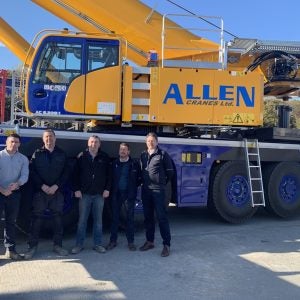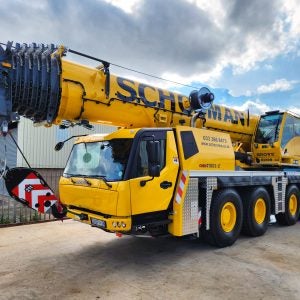Everyone knows that e-mail and the internet has brought about a revolution in communications, that the information flow between customers and suppliers has been made faster and easier. As a result, we can use our personal computers either at home or in the office, browse through catalogues or virtual supermarkets and order practically anything over the internet. Within days – hours sometimes – we can have it delivered to our doorstep.
There’s no doubt about it. The logistics flow from customer to supplier has really changed.
However, what has barely changed at all is the mechanisms of the supply chain working in the other direction. Music aside, where the product can now be delivered over the wire, into your computer and out again, suppliers are stuck with relying on old fashioned road, rail and aircraft to deliver the product to the consumer. The predicted end result of all this consumer and business e-commerce is a dramatic increase in the number of truck movements as goods are delivered to householders.
And just as the number of deliveries will increase, the size of each delivery will be smaller – a typical delivery might be a single book that has been ordered from Amazon.com, for example.
The challenge for logistics companies today is to move the goods from suppliers to customers as quickly as information flows through the internet. Of course, they cannot absolutely match the speed, but without significant improvements, e-commerce will remain of only marginal benefit to the supply chain.
This is where Austrian crane manufacturer Palfinger comes in. Truck loader cranes have long helped logistics companies improve their performance, but Palfinger is diversifying beyond conventional truck loaders. Six years ago about 95% of Palfinger’s revenues came from truck loaders; today that figure is about 60% and falling. Palfinger’s president and chief executive officer Dr Klaus Schützdeller explains the company’s philosophy.
“Everyone is working on the information flow from customer to supplier,” says Schützdeller. “We are working on the logistics flow the other way – the delivery. We can save time in the logistics chain by improving the interfaces.” Palfinger contributes to the logistics chain not just with its truck loader cranes, but also with its transportable forklift, the Crayler, which stows away under the truck. The Crayler comes in two sizes, 2.5t and 3.5t capacities. It is designed for lifting pallets and there are no plans to develop larger versions as container handling is a different market. Besides, says Schützdeller, “we are targeting the logistics chain of the e-commerce business where volumes are getting smaller and smaller, not bigger and bigger.” This also explains, in part, Palfinger’s development of its range of small cranes when so many other loader manufacturers are concentrating their efforts on high capacity and extra reach. It is only in the past three years that Palfinger has offered small cranes.
Schützdeller believes, as do many others, that roads alone will not be able to cope with the increase in traffic and therefore intermodal transfers – road/rail interchanges in particular – will have to be much more efficient. For this reason Palfinger has come up with another way to improve the interface in the chain, the Mobiler.
The Mobiler is a device fitted onto the back of a standard truck for sliding containers horizontally on/off trucks to/from rail wagons. It obviates the need for a third party materials handling company at the interchange, thus saving money. The truck driver, using a remote control console, can slide the container onto or off the train unaided, according to Palfinger, in less than five minutes.
Developed last year, today there are now two reference systems in use, one in Germany at a PreussenElektra facility and one in Switzerland by the fast food retail chain McDonalds. The payback comes within six months, says Schützdeller who expects Palfinger to sell about 50 units of the Mobiler attachment this year.
More radical initiatives are also in hand. Schützdeller says that in five or 10 years, containers and pallets will be fitted with a microchip containing information on the contents such as sell-by date and delivery schedule. When that time comes, Palfinger intends that its cranes are prepared. “We have to integrate our products, giving them the ability to read this information and transmit it, combined with the internet information flow,” says Schützdeller. The crane will tell you, remotely, what it is lifting.
From here it is a small step to cranes becoming robots – and Palfinger intends to take the lead here too. Says Schützdeller: “Robots are very flexible but they are limited to 500kg [capacity] because of the limitations of electric motors.” Palfinger’s expertise is in hydraulics, which is what was used to power robots 30 years ago. But as robot manufacturers moved over to electrics, sacrificing power for speed, they gradually lost all their expertise in hydraulics. “There’s no hydraulic robot in the world. That’s what we are working on,” says Schützdeller.
Palfinger already has the necessary expertise in hydraulics and last October it brought in robot expertise when it brought onto its board Lothar Bakowsky from robot manufacturer Kuka Robotertechnik.
Bakowsky is responsible for the process of innovation at Palfinger, as well as marketing and distribution.
Palfinger is growing quickly. It reckons that it is now the world’s biggest manufacturer of truck loader cranes, outselling Sweden’s Hiab (a claim naturally disputed by Hiab). Last year it became a publicly quoted company after its initial public offering (IPO) and acquired Guima, the French manufacturer of hook loaders. And with Craylers, Mobilers, intelligent cranes and robots, it is branching out to help speed up the supply chain. The way Schützdeller tells it, it is a clear, and rather exciting, vision.






